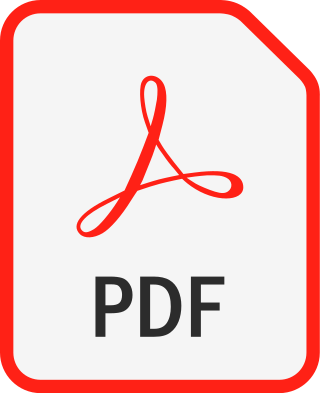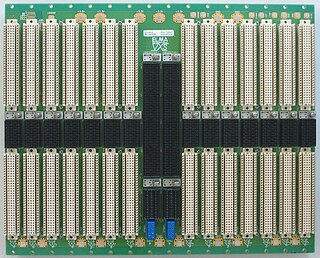
The Open Systems Interconnection (OSI) model is a reference model from the International Organization for Standardization (ISO) that "provides a common basis for the coordination of standards development for the purpose of systems interconnection." In the OSI reference model, the communications between systems are split into seven different abstraction layers: Physical, Data Link, Network, Transport, Session, Presentation, and Application.

Portable Document Format (PDF), standardized as ISO 32000, is a file format developed by Adobe in 1992 to present documents, including text formatting and images, in a manner independent of application software, hardware, and operating systems. Based on the PostScript language, each PDF file encapsulates a complete description of a fixed-layout flat document, including the text, fonts, vector graphics, raster images and other information needed to display it. PDF has its roots in "The Camelot Project" initiated by Adobe co-founder John Warnock in 1991. PDF was standardized as ISO 32000 in 2008. The last edition as ISO 32000-2:2020 was published in December 2020.

Vector graphics are a form of computer graphics in which visual images are created directly from geometric shapes defined on a Cartesian plane, such as points, lines, curves and polygons. The associated mechanisms may include vector display and printing hardware, vector data models and file formats, as well as the software based on these data models. Vector graphics are an alternative to raster or bitmap graphics, with each having advantages and disadvantages in specific situations.

Configuration management (CM) is a management process for establishing and maintaining consistency of a product's performance, functional, and physical attributes with its requirements, design, and operational information throughout its life. The CM process is widely used by military engineering organizations to manage changes throughout the system lifecycle of complex systems, such as weapon systems, military vehicles, and information systems. Outside the military, the CM process is also used with IT service management as defined by ITIL, and with other domain models in the civil engineering and other industrial engineering segments such as roads, bridges, canals, dams, and buildings.
The JPEG File Interchange Format (JFIF) is an image file format standard published as ITU-T Recommendation T.871 and ISO/IEC 10918-5. It defines supplementary specifications for the container format that contains the image data encoded with the JPEG algorithm. The base specifications for a JPEG container format are defined in Annex B of the JPEG standard, known as JPEG Interchange Format (JIF). JFIF builds over JIF to solve some of JIF's limitations, including unnecessary complexity, component sample registration, resolution, aspect ratio, and color space. Because JFIF is not the original JPG standard, one might expect another MIME type. However, it is still registered as "image/jpeg".
Tag Image File Format or Tagged Image File Format, commonly known by the abbreviations TIFF or TIF, is an image file format for storing raster graphics images, popular among graphic artists, the publishing industry, and photographers. TIFF is widely supported by scanning, faxing, word processing, optical character recognition, image manipulation, desktop publishing, and page-layout applications. The format was created by the Aldus Corporation for use in desktop publishing. It published the latest version 6.0 in 1992, subsequently updated with an Adobe Systems copyright after the latter acquired Aldus in 1994. Several Aldus or Adobe technical notes have been published with minor extensions to the format, and several specifications have been based on TIFF 6.0, including TIFF/EP, TIFF/IT, TIFF-F and TIFF-FX.
An open file format is a file format for storing digital data, defined by an openly published specification usually maintained by a standards organization, and which can be used and implemented by anyone. An open file format is licensed with an open license. For example, an open format can be implemented by both proprietary and free and open-source software, using the typical software licenses used by each. In contrast to open file formats, closed file formats are considered trade secrets.
The System Management Bus is a single-ended simple two-wire bus for the purpose of lightweight communication. Most commonly it is found in chipsets of computer motherboards for communication with the power source for ON/OFF instructions. The exact functionality and hardware interfaces vary with vendors.

The Initial Graphics Exchange Specification (IGES) is a vendor-neutral file format that allows the digital exchange of information among computer-aided design (CAD) systems. It is an ASCII-based textual format.
ISO 10303 is an ISO standard for the computer-interpretable representation and exchange of product manufacturing information. It is an ASCII-based format. Its official title is: Automation systems and integration — Product data representation and exchange. It is known informally as "STEP", which stands for "Standard for the Exchange of Product model data". ISO 10303 can represent 3D objects in Computer-aided design (CAD) and related information.
STEP-file is a widely used data exchange form of STEP. ISO 10303 can represent 3D objects in computer-aided design (CAD) and related information. Due to its ASCII structure, a STEP-file is easy to read, with typically one instance per line. The format of a STEP-file is defined in ISO 10303-21 Clear Text Encoding of the Exchange Structure.

The RapidIO architecture is a high-performance packet-switched electrical connection technology. It supports messaging, read/write and cache coherency semantics. Based on industry-standard electrical specifications such as those for Ethernet, RapidIO can be used as a chip-to-chip, board-to-board, and chassis-to-chassis interconnect.
An ibis is a long-legged bird.
Input/output Buffer Information Specification (IBIS) is a specification of a method for integrated circuit vendors to provide information about the input/output buffers of their product to their prospective customers without revealing the intellectual property of their implementation and without requiring proprietary encryption keys. From version 5.0, specification contains two separate types of models, "traditional IBIS" and "IBIS-AMI." The traditional model is generated in text format and consists of a number of tables that captures current vs. voltage (IV) and voltage vs. time (Vt) characteristics of the buffer, as well as the values of certain parasitic components. It is a standard data exchange format for exchanging modeling information among semiconductor device suppliers, simulation software suppliers, and end users.
Logistics Support Analysis (LSA) is a structured approach to increase efficiency of maintenance and reduces the cost of providing support by preplanning all aspects of Integrated Logistics Support. A successful LSA will define those support requirements that are ideal for the system design.
A Touchstone file was originally a proprietary file format for the eponymous frequency-domain linear circuit simulator from EEsof, launched in 1984 and acquired by HP. The simulator has been called HP/EEsof, then its engine has been successively included in the jOmega and ADS software suites and it is now owned by Keysight.

ArchiMate is an open and independent enterprise architecture modeling language to support the description, analysis and visualization of architecture within and across business domains in an unambiguous way.
ZPAQ is an open source command line archiver for Windows and Linux. It uses a journaling or append-only format which can be rolled back to an earlier state to retrieve older versions of files and directories. It supports fast incremental update by adding only files whose last-modified date has changed since the previous update. It compresses using deduplication and several algorithms depending on the data type and the selected compression level. To preserve forward and backward compatibility between versions as the compression algorithm is improved, it stores the decompression algorithm in the archive. The ZPAQ source code includes a public domain API, libzpaq, which provides compression and decompression services to C++ applications. The format is believed to be unencumbered by patents.

VMEBus Switched Serial, commonly known as VXS, is an ANSI standard that improves the performance of standard parallel VMEbus by enhancing it to support newer switched serial fabrics. The base specification defines all common elements of the standard, while "dot"-specifications define extensions which use specific serial fabrics or additional functionality. VXS is backward compatible with VMEBus. It is defined by the VME International Trade Association (VITA) working group.






